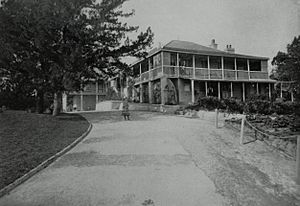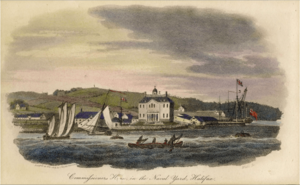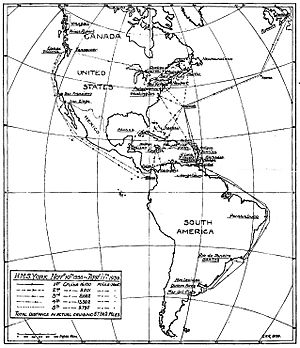North America and West Indies Station facts for kids
Quick facts for kids North America and West Indies Station |
|
|---|---|
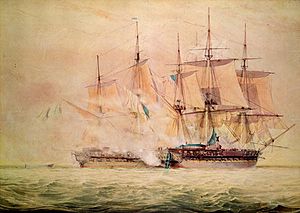
The capture of USS Chesapeake on 1 June 1813 as depicted by John Christian Schetky
|
|
| Active | North American Station (1745–1818) North America and West Indies Station (1818–1926) America and West Indies Station (1926–1956) West Indies (1956–1976) HMS Malabar (1976–1995) |
| Country | United Kingdom, Bermuda, and Canada |
| Branch | |
| Type | Regional command |
| Part of | Royal Navy |
| Garrison/HQ | Royal Naval Dockyard, Halifax 1745–1905 & Royal Naval Dockyard, Bermuda 1795–1956; HM Naval Base Bermuda HMS Malabar (South Yard of the Royal Naval Dockyard, Bermuda) 1956-1976 (closing in 1995) |
| Notable ships | Fame, Invincible, Leopard, Resolute |
| Engagements | Battle of Craney Island, Battle of the Chesapeake, Battle of Cape Henry, Siege of Yorktown, Battle of St. Kitts (American Revolutionary War) USS Constitution vs HMS Guerriere, Capture of HMS Frolic, Capture of USS Chesapeake, Capture of HMS Boxer, Burning of Washington (Chesapeake Campaign), Battle of Baltimore (Chesapeake Campaign) (War of 1812), pursuit of SM U-53 (1916), Battle of the Atlantic |
| Disbanded | 1 April 1976 |
The North America and West Indies Station was an important part of the Royal Navy (the British navy). It was a military command that operated in the waters around North America from 1745 to 1956. Its main bases were strongholds called Imperial fortresses in Bermuda and Halifax, Nova Scotia.
The station was first known as the North American Station. It was separate from the Jamaica Station until 1830. Then, the two joined to form the North America and West Indies Station. It was briefly closed in 1907 but reopened in 1915. In 1926, its name changed again to the America and West Indies Station.
Contents
History of the Station

The Royal Navy created this group of ships in 1745. Its goal was to fight against French forces in North America. The main office was at the Halifax Naval Yard in Nova Scotia. Today, this is CFB Halifax.
The area was first called the North American Station in 1767. Commodore Samuel Hood was in charge. Halifax was the main base from 1758 to 1794. After that, both Halifax and Bermuda were used. The Royal Navy bought land for a permanent naval yard in 1758. The yard officially opened in 1759. It was the main base for the Royal Navy in North America during several wars. These included the Seven Years' War and the American Revolution.
Bermuda Becomes a Key Base
After America became independent in 1783, Bermuda was the only British land left. It was located between Nova Scotia and the West Indies. So, it was chosen as the new main base for the region. Building a base there took a long time. The navy first had to map the coral reefs. They needed to find safe paths for large warships.
Once the mapping was done, a base opened in St. George's in 1794. The fleet anchored at Murray's Anchorage. This spot was named after Vice Admiral Sir George Murray. He became the Commander-in-Chief of the new station. The Admiralty also started buying land at Bermuda's West End. They planned to build the Royal Naval Dockyard, Bermuda. This would be a permanent naval base. Its anchorage would be on Grassy Bay. Building this base took most of the 1800s.
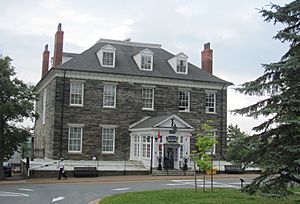
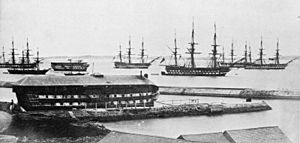

War of 1812 Operations
Admiral Sir John Borlase Warren became Commander-in-Chief in 1812. He and his team spent most of the War of 1812 in Bermuda. From there, they planned the blockade of the United States' Atlantic Seaboard. They also organized raids like the Battle of Craney Island. Sir John was replaced by Vice Admiral Sir Alexander Inglis Cochrane in 1813.
In 1814, 2,500 soldiers arrived in Bermuda. They were led by Major-General Robert Ross. These soldiers joined the naval and military forces already there. Together, they launched the Chesapeake campaign. This was a mission that included the Raid on Alexandria. It also involved the Battle of Bladensburg and the Burning of Washington in August 1814.
Changes in Command and Importance
In 1813, the command area became the North America Station again. The West Indies fell under the Jamaica Station. In 1816, it was renamed the North America and Lakes of Canada Station. The headquarters was in Bermuda during winter and Halifax in summer. But Admiralty House, Bermuda, became the year-round headquarters in 1821. At that time, the area was called the North America and Newfoundland Station.
By 1819, Bermuda became the main base all year. It was better located to respond to threats from the United States. Halifax continued to be the summer base until 1907. Bermuda was very important after the war. It was almost impossible to attack by sea or land. Royal Naval Purser Richard Cotter wrote in 1828:
The possession of Bermuda, as the key of all our Western Colonies, is of the first importance to England, for if a foe of any maritime strength had possession of it, our trade would be exposed to much annoyance, if not total destruction.
Sir Henry Hardinge spoke in the House of Commons in 1839. He said Bermuda was one of Britain's most important posts. It was a place where the navy could easily repair ships. During the last war, it held stores worth about £2 million. Ships could always find shelter there. He stressed that Bermuda needed to be kept very safe.
Twentieth Century Changes
In 1830, the station took over the Jamaica Station. It was then called the North America and West Indies Station. This name lasted until 1907. At that point, the station was closed. Its ships were replaced by the 4th Cruiser Squadron. This squadron was based in England. Bermuda became a coaling station, but the dockyard stayed open. The Commander-in-Chief remained in Bermuda. The Royal Navy left Halifax in 1905. The Halifax Naval Yard was given to the Royal Canadian Navy in 1910.
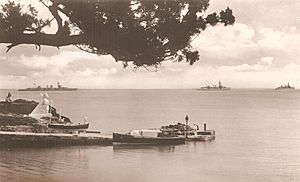
The North America and West Indies Station was brought back in 1915. It included the 8th Cruiser Squadron from 1924 to 1925. It also took over the area that used to belong to the Pacific Station. In 1928, South America was added to its area. The station was renamed the "America and West Indies Station".
During World War II, in 1942, the title of Commander-in-Chief was changed. It became Senior British Naval Officer, Western Atlantic. This meant the British officer reported to the United States Navy. The Allied command in the North Atlantic was split. The US took command in the West, and the UK in the East. In 1945, the America and West Indies title was restored.
In 1951, the Royal Naval Dockyard in Bermuda became smaller. It no longer had drydock facilities. The Royal Navy kept a Berthing Area at the South Yard. This area was commanded by a Resident Naval Officer (RNO). Ships of the America and West Indies Squadron continued to be based there. However, their major repairs were done in Britain.
End of the Station
On October 29, 1956, the role of Commander-in-Chief, America and West Indies Station, ended. The Senior Naval Officer, West Indies (SNOWI) took over. SNOWI reported directly to the Commander-in-Chief, Home Fleet in the United Kingdom. SNOWI also served as Island Commander Bermuda (ISCOMBERMUDA) for NATO. The command was reduced to just two Station Frigates.
All remaining naval land in Bermuda was sold to the local government. This happened between 1957 and 1965. The part of the dockyard still needed for naval operations was leased. It became the South Yard Berthing Area. On June 1, 1965, this area was named HMS Malabar.
In December 1967, the RNO Bermuda position was removed. Its duties went to SNOWI's secretary. SNOWI then took command of HMS Malabar. But because SNOWI was often away in the West Indies, a Lieutenant-Commander was appointed. This officer became the Commanding Officer of HMS Malabar and RNO in 1971.
On April 1, 1976, the SNOWI position was ended. The Station Frigates were also removed. The RNO and staff remained. A frigate was appointed as the West Indies Guardship. But it rarely visited Bermuda. HMS Malabar stopped being a base and was only a supply station.
By 1995, HMS Malabar was given to the Government of Bermuda. The Royal Navy's presence in the North-Western Atlantic and Caribbean was very small. It was just the West Indies Guard Ship. This role was rotated among the fleet's escort ships. They took turns patrolling the West Indies.
Years later, the West Indies Guard Ship task was renamed Atlantic Patrol Task (North).
Sub Commands
- Jamaica Division (naval vessels)
- Jamaica Dockyard (shore base)
Commanders in Chief
These are some of the officers who commanded the station. A ![]() means they died while in command.
means they died while in command.
Commander-in-Chief, North American Station
- Commodore James Douglas (1746–48)
- Commodore Charles Watson (1748–49)
- Commodore Augustus Keppel (1754–55)
- Vice-Admiral Edward Boscawen (1755–56)
- Commodore Lord Colville (November 1759 – October 1762)
- Commodore Richard Spry (October 1762 – October 1763)
- Rear Admiral Lord Colville (October 1763 – September 1766)
- Captain Joseph Deane (September 1766 – November 1766)
- Captain Archibald Kennedy (November 1766 – July 1767)
- Commodore Samuel Hood (July 1767 – October 1770)
- Commodore James Gambier (October 1770 – August 1771)
- Rear Admiral John Montagu (August 1771 – June 1774)
- Vice Admiral Samuel Graves (June 1774 – January 1776)
- Vice Admiral Richard Howe (February 1776 – September 1778)
- Vice Admiral James Gambier (1778–79)
- Vice Admiral John Byron (1779)
- Vice Admiral Mariot Arbuthnot (1779–81)
- Vice Admiral Sir Thomas Graves (1781)
- Rear Admiral Robert Digby (1781–83)
- Rear Admiral Sir Charles Douglas (1783–85)
- Vice Admiral Sir Herbert Sawyer (1785–89)
- Vice Admiral Sir Richard Hughes (1789–92)
- Captain Sir Rupert George (1792-1794)
- Vice Admiral George Murray (1794–96)
- Vice Admiral George Vandeput (1797–1800)

- Vice Admiral Sir William Parker (1800–02)
- Vice Admiral Sir Andrew Mitchell (1802–06)

- Vice Admiral Sir George Cranfield Berkeley (1806–07)
- Vice Admiral Sir John Warren (1807–10)
- Vice Admiral Sir Herbert Sawyer (1810–13)
- Admiral Sir John Warren (1813–14)
- Vice Admiral Sir Alexander Cochrane (1814–15)
- Vice Admiral Sir David Milne (1816)
- Vice Admiral Sir Edward Colpoys (1816–21)
Commander-in-Chief, North America and West Indies Station
- Vice Admiral Sir William Fahie (1821–24)
- Vice Admiral Sir Willoughby Lake (1824–27)
- Vice Admiral Sir Charles Ogle (1827–30)
- Vice Admiral Sir Edward Colpoys (1830–32)
- Vice Admiral Sir George Cockburn (1832–36)
- Vice Admiral Sir Peter Halkett (1836–37)
- Vice Admiral Sir Charles Paget (1837–39)

- Commodore Peter John Douglas (1839)
- Vice Admiral Sir Thomas Harvey (1839–41)

- Commodore Peter John Douglas (1841)
- Vice Admiral Sir Charles Adam (1841–44)
- Vice Admiral Sir Francis Austen (1844–48)
- Vice Admiral Sir Thomas Cochrane (1848–51)
- Vice Admiral Sir George Seymour (1851–53)
- Vice Admiral Sir Arthur Fanshawe (1853–56)
- Vice Admiral Sir Houston Stewart (1856–60)
- Vice Admiral Sir Alexander Milne (1860–64)
- Vice Admiral Sir James Hope (1864–67)
- Vice Admiral Sir Rodney Mundy (1867–69)
- Vice Admiral Sir George Wellesley (1869–70)
- Vice Admiral Sir Edward Fanshawe (1870–73)
- Vice Admiral Sir George Wellesley (1873–75)
- Vice Admiral Sir Astley Key (1875–78)
- Vice Admiral Sir Edward Inglefield (1878–79)
- Vice Admiral Sir Francis McClintock (1879–82)
- Vice Admiral Sir John Commerell (1882–85)
- Vice Admiral The Earl of Clanwilliam (1885–86)
- Vice Admiral Sir Algernon Lyons (1886–88)
- Vice Admiral Sir George Watson (1888–91)
- Vice Admiral Sir John Hopkins (1891–95)
- Vice Admiral Sir James Erskine (1895–97)
- Vice Admiral Sir Jackie Fisher (1897–99)
- Vice Admiral Sir Frederick Bedford (1899–15 July 1902)
- Vice Admiral Sir Archibald Douglas (15 July 1902 – 1904)
- Vice Admiral Sir Day Bosanquet (1904–07)
- Vacant (1907–13)
- Vice Admiral Sir Christopher Cradock (1913–14)

- Rear Admiral Robert Hornby (1914–15)
- Vice Admiral Sir George Patey (1915–16)
- Vice Admiral Sir Montague Browning (1916–18)
- Vice Admiral Sir William Grant (1918–19)
- Vice Admiral Sir Morgan Singer (1919)
- Vice Admiral Sir Trevylyan Napier (1919–20)

- Vice Admiral Sir William Pakenham (1920–23)
- Vice Admiral Sir Michael Culme-Seymour (1923–24)
- Vice Admiral Sir James Fergusson (1924–26)
Commander-in-Chief, America and West Indies Station
- Vice Admiral Sir Walter Cowan (1926–28)
- Vice Admiral Sir Cyril Fuller (1928–30)
- Vice Admiral Sir Vernon Haggard (1930–32)
- Vice Admiral Sir Reginald Plunkett (1932–34)
- Vice Admiral Sir Matthew Best (1934–37)
- Vice Admiral Sir Sidney Meyrick (1937–40)
- Vice Admiral Sir Charles Kennedy-Purvis (1940–41)
- Vice Admiral Sir Charles Kennedy-Purvis (1942)
- Vice Admiral Sir Alban Curteis (1942–44)
- Vice Admiral Sir Irvine Glennie (1944–45)
Commander-in-Chief, America and West Indies Station (Restored)
- Vice Admiral Sir William Tennant (1946–49)
- Vice Admiral Sir Richard Symonds-Tayler (1949–51)
- Vice Admiral Sir William Andrewes (1951–53)
- Vice Admiral Sir John Stevens (1953–55)
- Vice Admiral Sir John Eaton (1955–56)
Images for kids
-
On lookout for U-boats in the Battle of the Atlantic, October 1941
See also
- List of fleets and major commands of the Royal Navy
- Military history of Nova Scotia
- Military history of Canada
- Commander-in-Chief, North America
- Imperial fortress


